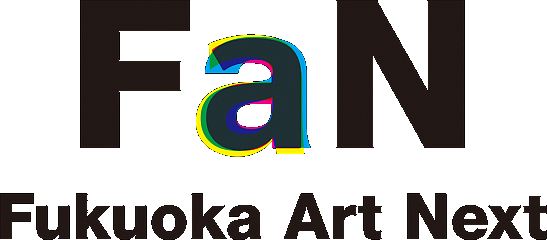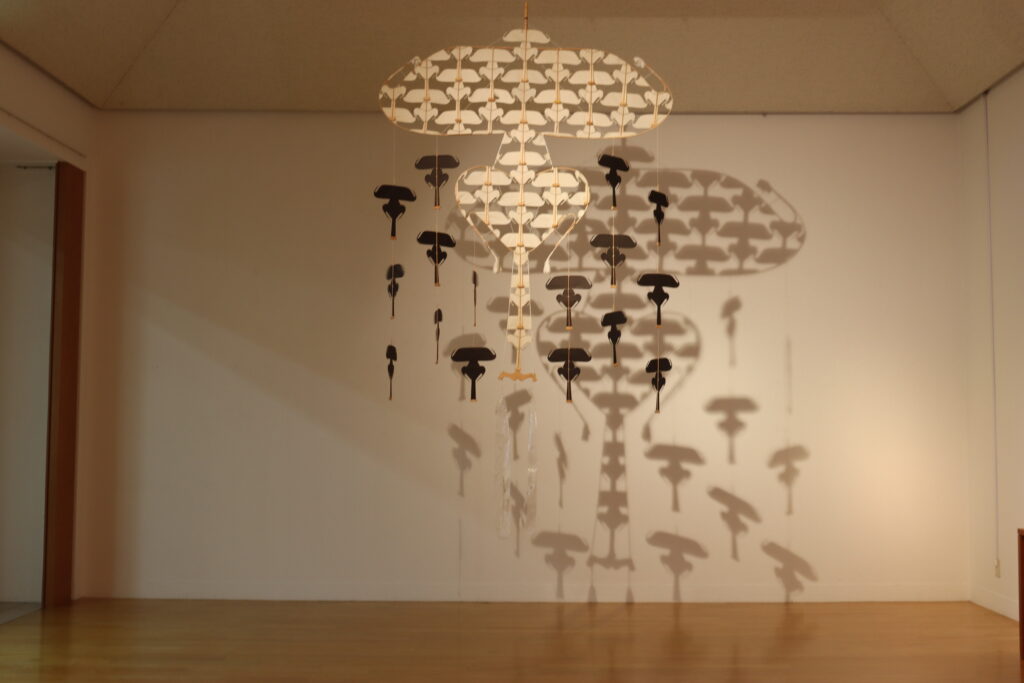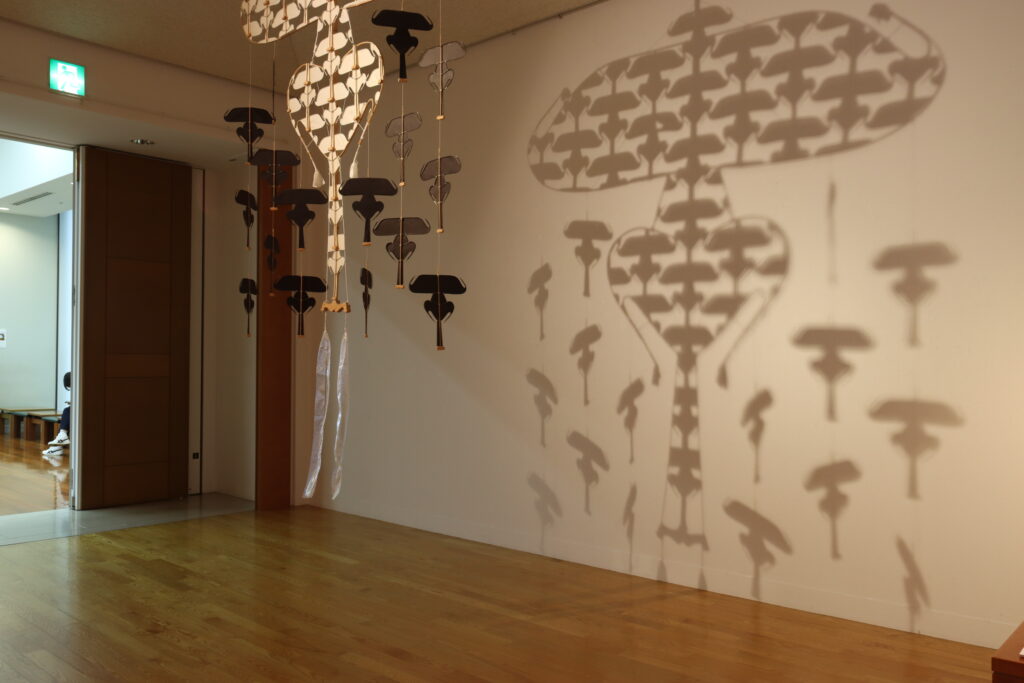
Room for FAAM Residence Program Part 3 The Flying Kite in the Sky : Soeung Vannara
- Period
- Jan 2, 2024 〜 Apr 9, 2024
- Venue
アジアギャラリー
Since opening in 1999, Fukuoka Asian Art Museum has been conducting its annual Artist in Residence Program, inviting Asian artists and researchers for a period of time that enables them to interact with citizens through collaborative art-making, workshops, and talk events. In 2022, as part of Fukuoka Art Next (a new governmental policy that supports emerging local artists), FAAM renewed this program and invited eight artists (including duos) across Japan and worldwide through its open call for them to work at the newly located studio in Artist Cafe Fukuoka. We wish to offer a glimpse of what we’ve done so far in the Artist in Residence Program over the years and introduce later achievements of the previously invited artists in this new series of exhibitions, Room for FAAM Residence Program, which started in 2019.
This time, we introduce Soeung Vannara, an artist from Cambodia who participated in the 2nd Fukuoka Asian Art Triennale 2002. Vannara, who saw Cambodian kites as symbols of peace and freedom, organized a workshop to make musical kites with local citizens and a kite-flying competition during his stay in Fukuoka. His message for peace was consistent throughout the making of experimental kites and another large-scale kite, created in collaboration with a traditional Japanese painting artist based in Fukuoka. By looking at his works, we hope to reconsider the meaning of peace in our society amid ongoing conflicts and civil wars across the globe.
We are also pleased to include a new piece of work by Shimizu Miho, one of the invited artists for the first period of Artist in Residence Program 2023 (between July and September 2023). Similar to Vannara, Shimizu had a strong interest in kites and has been researching about kites in Vietnam and also in northern Kyushu. Her new work on view was made as a response to Vannara’s activities.
Soeung Vannara(Cambodia)
Residency Period: June 4 – September 3, 2002
Soeung Vannara was born in Kandal, Cambodia, in 1962. In 1995, he received a master’s degree at the Academy of Fine Arts, Warsaw, Poland. He then taught at the Faculty of Plastic Arts, the Royal University of Fine Arts, Phnom Penh. Vannara is one of the first generation of contemporary artists who appeared after the Khmer Rouge.
At the 2nd Fukuoka Asian Art Triennale 2002, Vannara exhibited his oil painting representing abstract figures of barbed wire, in which he embedded his prayer for the victims of the Khmer Rouge and criticism towards the military regime at the time. Having lost his father who worked as a sculptor under the Pol Pot regime, Vannara had a strong aspiration for peace which led him to make kites as a symbol of peace in Fukuoka.
In Cambodia, where there is a long tradition of kites, people hold kite-flying festivals at the end of harvest season. Vannara saw the kite-flying festival as an event of community, and he wished to create a place for everyone, from children to elders, to make kites together and share the joy of seeing flying kites above the sky in Fukuoka.
During his stay in 2002, Vannara made and flew the kites with the local junior high school students. He also invited local people to join the making and flying competition Tako Cup 2002. Vannara’s thoughts for peace were sent beyond national borders and resulted in making traditional Cambodian musical kites with people in Fukuoka. Participants enjoyed making and flying their kites, sometimes seriously and sometimes with big laughter.
Moreover, Vannara worked in collaboration for the first time, with a traditional Japanese painting artist, Narayama Sumi, from Fukuoka. Vannara drew patterns of plants representing the land of Cambodia on the right side of a large-scale kite, while on the left Narayama depicted crushing waves illustrating the ocean of Japan. The two patterns combine at the center, and an instrument for making sounds is attached on the front edge. During the residency artist’s exhibition in 2002, visitors were able to hear the sounds from the instrument which moves by the wind from electric fans set up in the gallery.
Vannara has been active in various fields of art, including oil painting, sculpture, installation, and some other unique attempts using computers. The artist continues to work on memories of the Khmer Rouge.
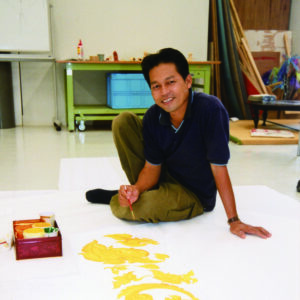
Workshop for Making Kites
Vannara made traditional Cambodian kites with many local people during his stay in Fukuoka in 2002. As one of the participating artists for the 2nd Fukuoka Asian Art Triennale 2002 (hereinafter “Triennale”) that ran from March 21 until June 23, 2002, Vannara also collaborated with local junior high school students to make Cambodian kites as part of the art exchange programs of the Triennale. During the late half of his stay, while working on his own artwork, Vannara also organized a kite-making workshop Taco Cup 2002, and invited local citizens.
1.Kite-Making with the Local Junior High School Students
Date: July 22 – 27, 2002
Place: Open Studio (FAAM)and Art studio at the school
Participants: 12 art club students at Maizuru Junior High School
Vannara talked about Cambodian culture and life with kites to the students who visited the Open Studio. He then taught them how to make the traditional Cambodian kites. However, his instructions were challenging for students. Since they did not finish making the kite that day, as it needed special care and skills, Vannara visited their school later to continue the workshop. The artist flew the kite at the beach of Momochihama after its completion.
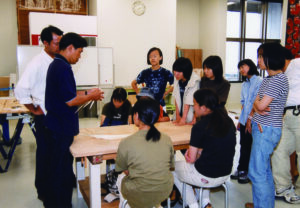
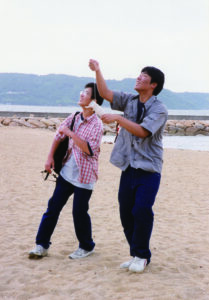
2.Workshop: Taco Cup 2002
Date: July 27 – September 1, 2002
Place: Open Studio (FAAM) and Fukuoka City Beach Park
Participants: 12 people for making kites/ 29 people for the kite-flying competition
Vannara held a workshop in the Open Studio at FAAM on July 27, 2002, and explained how to make a traditional Cambodian musical kite. Everyone worked hard to make the kites with shaved bamboo, design patterns on cloth that would be stretched on the kite’s surface, and make the instrumental attachments that played sounds when flying the kite. They regularly visited the studio for a month and completed making a variety of unique kites.
The kite-flying competition Taco Cup was finally held after postponement since it required extra days to finish making. Several kites made a big whirring sound in the wind at the venue and went up high above the sky.
Vannara reviewed how well each kite flew and the designs of each pattern on the kites. At the end of the competition, the artist gave an award to the winner.
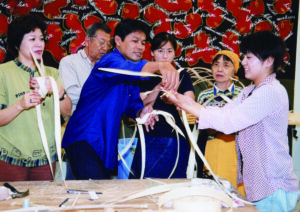
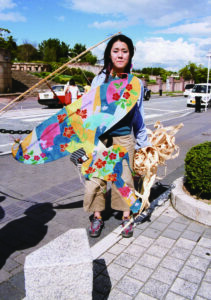

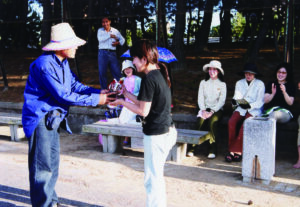
Experiments on Making Kites
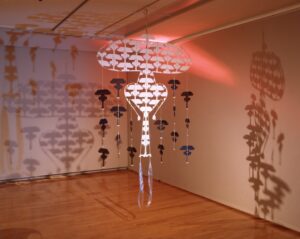
“Shadow Kite” 2002

“Khmer Musical Kite in Cooperation” 2002
A Response from Another Residency Artist after 20 years
To Soeung Vannara, From Shimizu Miho
“I heard that Mr. Vannara said he felt a sense of freedom after arriving in Fukuoka and wished to share his joy of flying the kites with people. This episode reminds us of the fact that memories of the Khmer Rouge are not far past. As we are surrounded by the news of ongoing wars and conflicts, it would be meaningful to look at his artwork again.” ―Shimizu Miho
Shimizu Miho stayed in Fukuoka as one of the invited artists for the first period of FAAM Artist in Residence Program 2023. She has been researching on Asian kites and had a chance to see the Cambodian kites made by Soeung Vannara, who was invited for the residency in 2002. Through this experience, Shimizu decided to learn more about traditional Cambodian kites as part of her research and became interested in the relationship between Vannara and kites.
Having been informed of Soeung Vannara’s exhibition at FAAM starting in January 2024, Shimizu created her original kite based on her study of Vannara’s instructions written for his workshop for making Cambodian musical kites. The work was her homage to Vannara’s activities and artworks.

Portrait photo by Heidi Vogels
Shimizu Miho
Residency period: July 10 – September 27, 2023
Lives and works in Tokyo. Shimizu creates sets for live events and video productions, as well as costumes and props for performers and dancers. In recent years, she has been exploring themes such as dreams, puppetry, and kites, through exchanges with local communities and professionals in the field. The artist researched about kites, especially in northern areas of Kyushu, during her residency and created her own kite while receiving advice from professionals and researchers. The results of her research were also included in the exhibition with the works. She flew her Vietnamese instrumental kite and another original kite she made in Fukuoka at a kite-flying competition, where she was invited to join as a guest.

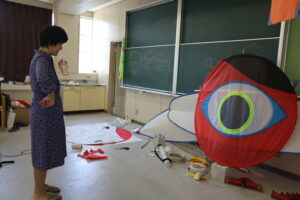
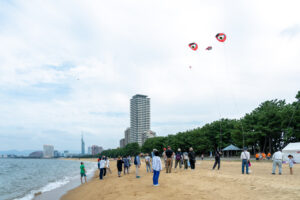
Photo by Kawasaki Ittoku
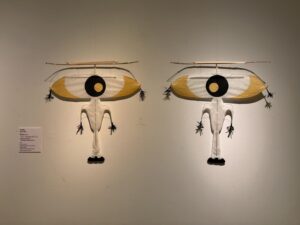
Virtual Museum”Room for FAAM Residence Program Part 3 The Flying Kite in the Sky: Soeung Vannara”
| Venue | アジアギャラリー |
|---|---|
| Admission | Adult: ¥200(¥150) High School/College: ¥150(¥100) Junior High Schooland Under: Free |
| Organiser | Fukuoka Asian Art Museum |
| Contact | 092-263-1100 |

